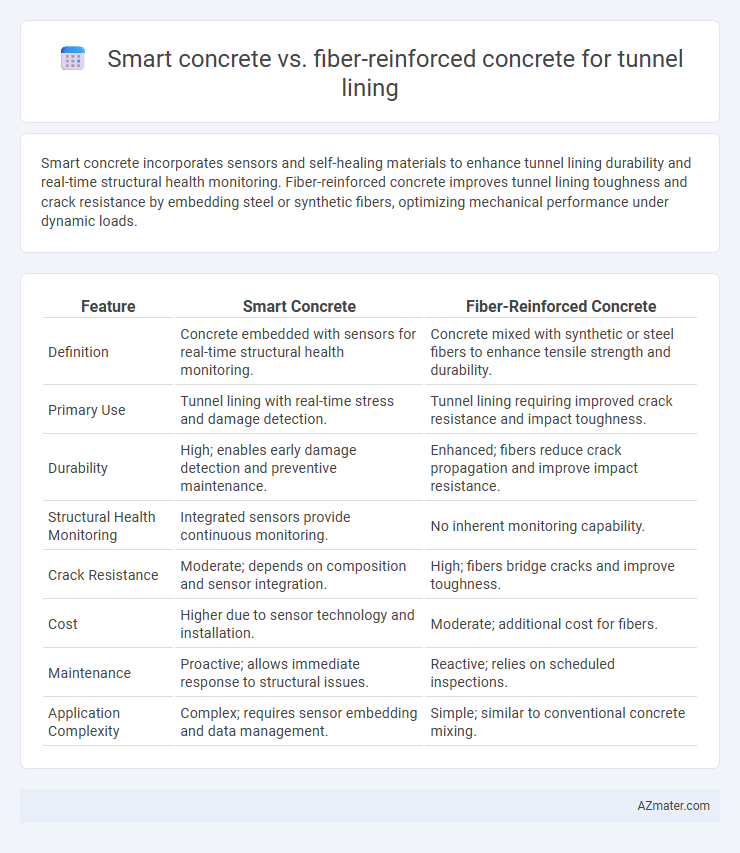Smart concrete incorporates sensors and self-healing materials to enhance tunnel lining durability and real-time structural health monitoring. Fiber-reinforced concrete improves tunnel lining toughness and crack resistance by embedding steel or synthetic fibers, optimizing mechanical performance under dynamic loads.
Table of Comparison
| Feature | Smart Concrete | Fiber-Reinforced Concrete |
|---|---|---|
| Definition | Concrete embedded with sensors for real-time structural health monitoring. | Concrete mixed with synthetic or steel fibers to enhance tensile strength and durability. |
| Primary Use | Tunnel lining with real-time stress and damage detection. | Tunnel lining requiring improved crack resistance and impact toughness. |
| Durability | High; enables early damage detection and preventive maintenance. | Enhanced; fibers reduce crack propagation and improve impact resistance. |
| Structural Health Monitoring | Integrated sensors provide continuous monitoring. | No inherent monitoring capability. |
| Crack Resistance | Moderate; depends on composition and sensor integration. | High; fibers bridge cracks and improve toughness. |
| Cost | Higher due to sensor technology and installation. | Moderate; additional cost for fibers. |
| Maintenance | Proactive; allows immediate response to structural issues. | Reactive; relies on scheduled inspections. |
| Application Complexity | Complex; requires sensor embedding and data management. | Simple; similar to conventional concrete mixing. |
Introduction to Advanced Tunnel Lining Materials
Smart concrete enhances tunnel lining by integrating self-sensing capabilities and adaptive responses to structural stress, improving real-time monitoring and durability. Fiber-reinforced concrete increases tensile strength and crack resistance through the incorporation of synthetic or steel fibers, providing enhanced structural integrity under dynamic loads. These advanced materials are pivotal in modern tunnel construction, offering improved safety, longevity, and cost-effectiveness compared to traditional concrete.
What is Smart Concrete?
Smart concrete incorporates embedded sensors and self-sensing materials that enable real-time monitoring of structural health, detecting strain, temperature, and cracks in tunnel linings. This innovative concrete integrates nano- or micro-scale conductive fibers or piezoelectric materials to provide continuous feedback, enhancing safety and maintenance efficiency. In contrast to fiber-reinforced concrete, which mainly improves mechanical strength, smart concrete delivers active durability assessment, critical for long-term tunnel infrastructure management.
Understanding Fiber-Reinforced Concrete (FRC)
Fiber-reinforced concrete (FRC) enhances tunnel lining durability by embedding synthetic, steel, or glass fibers into the concrete matrix, which improves tensile strength, toughness, and crack resistance. These fibers distribute stress more evenly and reduce micro-cracking, making FRC highly effective in resisting the harsh environmental conditions inside tunnels, such as vibrations and water ingress. Fiber type, dosage, and orientation significantly influence mechanical performance, optimizing structural integrity and extending service life in tunnel linings.
Comparative Durability: Smart Concrete vs FRC
Smart concrete incorporates self-sensing capabilities and crack-healing properties, enhancing its durability by detecting and repairing internal damage, which reduces maintenance frequency in tunnel lining applications. Fiber-reinforced concrete (FRC) improves tensile strength and crack resistance through the inclusion of synthetic, steel, or glass fibers, offering robust performance under dynamic loads and preventing brittle failure. Comparative durability analysis demonstrates that smart concrete excels in proactive degradation management, while FRC provides superior mechanical toughness, making their combined use ideal for maximizing tunnel lining lifespan.
Structural Performance and Load-Bearing Capacity
Smart concrete incorporates embedded sensors for real-time monitoring of structural health, enhancing safety and durability in tunnel lining applications through adaptive load assessment. Fiber-reinforced concrete improves load-bearing capacity by distributing tensile stresses and controlling crack propagation, resulting in increased toughness and resistance to dynamic loads. Comparative studies indicate that while fiber-reinforced concrete excels in mechanical strength, smart concrete's integrated sensing technology offers superior performance in predictive maintenance and long-term structural integrity.
Crack Detection and Self-Healing Capabilities
Smart concrete integrates sensors to monitor structural health in real-time, enabling early crack detection through embedded piezoelectric or fiber optic technologies, which is crucial for tunnel lining safety. Fiber-reinforced concrete enhances mechanical performance by distributing micro-cracks and delaying crack propagation, but its crack detection relies mainly on visual inspection or external sensors. Self-healing capabilities in smart concrete are often enhanced by encapsulated healing agents activated upon cracking, whereas fiber-reinforced concrete uses fibers like steel or polypropylene to improve toughness but typically lacks autonomous healing functions.
Installation Techniques and Construction Efficiency
Smart concrete for tunnel lining integrates sensors and self-healing properties, enabling real-time structural health monitoring and reducing maintenance needs, which enhances long-term construction efficiency. Fiber-reinforced concrete improves crack resistance and durability through the inclusion of synthetic or steel fibers, allowing faster setting times and reduced labor during installation. Both materials optimize construction workflows, but smart concrete requires advanced monitoring equipment installation, whereas fiber-reinforced concrete simplifies pouring and finishing processes.
Long-Term Maintenance and Lifecycle Costs
Smart concrete in tunnel lining offers real-time monitoring capabilities through embedded sensors, enabling early detection of structural issues and reducing long-term maintenance costs. Fiber-reinforced concrete enhances durability and crack resistance, lowering repair frequency but lacks integrated health monitoring features. Over the lifecycle, smart concrete provides a cost advantage by minimizing unexpected repairs, while fiber-reinforced concrete ensures extended service life with lower upfront expenses.
Sustainability and Environmental Impact
Smart concrete for tunnel lining incorporates sensors that monitor structural health, enabling timely maintenance and extending the lifespan of tunnels, which reduces material waste and environmental impact. Fiber-reinforced concrete enhances durability and crack resistance, decreasing repair frequency and resource consumption while offering improved structural performance. Both materials contribute to sustainability by lowering carbon footprint through extended service life and minimizing the need for frequent reconstruction or interventions.
Future Trends in Tunnel Lining Technologies
Smart concrete integrates sensors and self-healing materials that enable real-time monitoring and autonomous crack repair, enhancing tunnel safety and durability. Fiber-reinforced concrete improves mechanical strength and crack resistance by dispersing tensile stresses, offering a cost-effective solution for tunnel lining reinforcement. Future trends in tunnel lining technologies emphasize the combination of smart concrete's intelligence with fiber reinforcement's robustness to achieve adaptive, long-lasting tunnel infrastructures.

Infographic: Smart concrete vs Fiber-reinforced concrete for Tunnel lining
 azmater.com
azmater.com